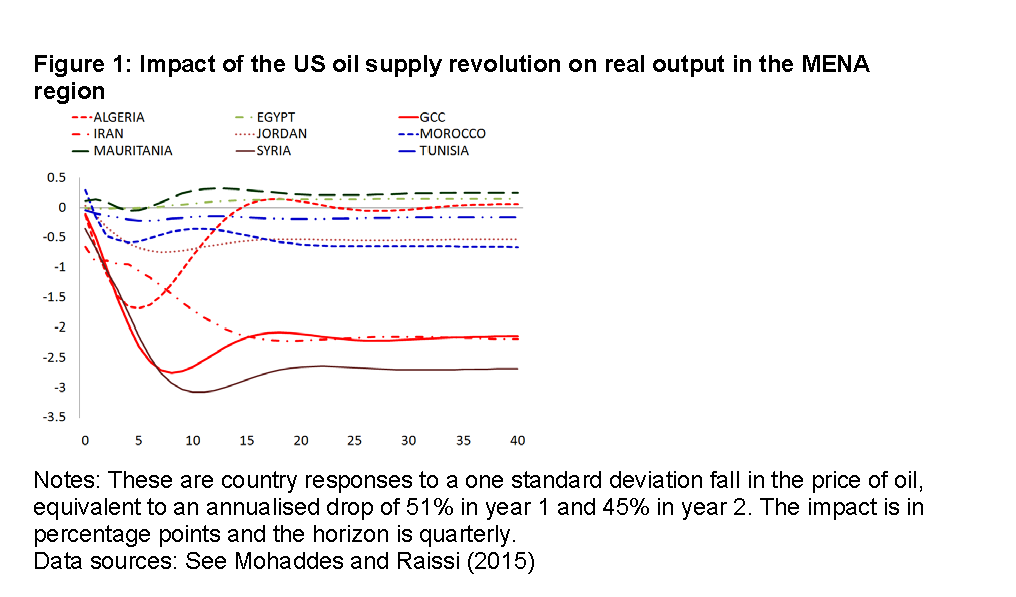In a nutshell
In response to the fall in oil prices, energy exporters face a decline in economic activity, mainly because lower oil prices weaken domestic demand as well as external and fiscal balances.
There are also negative growth effects for energy importers that have strong economic ties with oil exporters.
For the MENA countries, the current low oil price environment provides an opportunity for further subsidy and structural reforms.
One of the consequences of the shale oil revolution in the United States is that US oil production can play a significant role in balancing global demand for oil and supply of oil. This in turn implies that the current low oil price environment could be persistent: once oil prices start to rise again above certain thresholds, production from US unconventional oil will accelerate, limiting any price spikes.
Our research analyses the impact of low oil prices on the global economy, particularly the countries of the MENA region. We show that the Gulf Cooperation Council (GCC) countries and Iran face a long-lasting fall in their real output (more than 2% over the long run) following a positive US oil supply shock as lower oil prices weaken their external and fiscal balances (see Figure 1). For Algeria, an OPEC member, the response is negative for the first 14 quarters before stabilising around zero over the long run, reflecting its strong trade linkages with Europe (a region that tends to benefit from low oil prices).
Given that oil exporters in the region (with the exception of Saudi Arabia) are producing at (or near) capacity, they cannot readily increase their production levels to compensate for lower oil prices (owing in part to the US oil supply revolution) and maintain the same level of oil revenues. Even if they were able to increase production, this would only lead to an increase in global oil supply, which would in turn depress prices even further, at least in the short run and until current projects from high-cost fields are completed.
What are the long-run growth effects of oil revenue shocks for major oil exporters? We find that real output for MENA oil exporters – Algeria, Iran, Kuwait, Libya, Oman, Qatar, Saudi Arabia and the United Arab Emirates – in the long run is shaped first, by oil revenue through its impact on capital accumulation, and second, by technological spillovers.
Oil revenue shocks have a large, long-lasting and significant impact on the growth paths of these economies, operating through the capital accumulation channel. Moreover, these countries will be adversely affected whenever oil revenues decline and will benefit whenever they rise. Therefore, macroeconomic and structural policies should be conducted in a way that the vulnerability of these countries to oil revenue disturbances (not just price disturbances) is reduced.
These results have strong policy implications. Oil exporters in the MENA region and beyond are faced with substantial losses in government revenues as a result of a seemingly long-lasting oil price fall. With buffers eroding over the medium term, most countries will need to reassess their medium-term spending plans. Improvements in the conduct of macroeconomic policies, better management of resource income volatility and export diversification can all have beneficial growth effects; as do policies that increase the return on investment, such as public infrastructure developments and measures to enhance human capital.
Moreover, the creation of commodity stabilisation funds – or sovereign wealth funds, in the case of countries in the Persian Gulf – might be one way to offset the negative effects of commodity booms and slumps (provided the low oil price environment does not last for a long time).
While it is no surprise that MENA oil exporters are affected negatively by lower oil prices, the overall long-term effect on output for MENA oil importers is not clear cut, considering the direct and indirect effects of lower oil prices for these economies. While a fall in oil prices initially implies lower import costs for these economies, it also reflects a slowdown in oil-exporting countries, which in turn negatively affects these economies through trade, remittances, grants and foreign direct investment channels.
Overall, Figure 1 shows that the direct positive effect of lower oil prices for all oil importers (except Egypt and Mauritania) is dominated by the indirect negative impact of spillovers from the exporters (in particular from the GCC).
More specifically, for most oil importers in the MENA region, gains from lower oil prices are offset by a decline in external demand/financing by oil exporters over the medium term given the strong linkages between the two groups. The likely long-run negative growth effects on these countries are not trivial but they are much smaller than those for oil exporters: roughly -0.5%, -0.7% and -0.2% for Jordan, Morocco and Tunisia, respectively.
For Egypt (despite having a relatively large subsidy bill) and Mauritania, responses are positive and about 0.2% in the medium term. In general, low pass-through from global oil prices to domestic fuel prices limits the impact on the disposable incomes of consumers and the profit margins of firms in MENA oil importers, and thereby reduces the direct positive impact on economic growth in these countries.
The sensitivity of MENA countries – both oil exporters and importers – to oil market developments raises the question of which policies and institutions are needed in response to such shocks. While countercyclical fiscal policies are key to insulate the exporters from commodity price fluctuations, the other priority for commodity exporters should be to enhance their macroeconomic policy frameworks and institutions.
Oil importers in the region should not overestimate the positive impact of the decline in oil prices on their economies given considerable uncertainty about the persistence of lower oil prices and the availability of external financing and weak demand growth in oil-exporting trade partners. For the MENA countries, the current low oil price environment provides an opportunity for further subsidy and structural reforms.
Further reading
Mohaddes, Kamiar, and Mehdi Raissi (2017) ‘The U.S. Oil Supply Revolution and the Global Economy’, ERF Working Paper No. 1124.
Mohaddes, Kamiar, and Mehdi Raissi (2016) ‘The US Shale Oil Revolution Requires Major Reforms in the Macroeconomic Policy Frameworks and Institutions in the MENA Region’, ERF Policy Perspective No. 21.
Mohaddes, Kamiar, and Mehdi Raissi (2013) ‘Oil Prices, External Income, and Growth: Lessons from Jordan’, Review of Middle East Economics and Finance 9:2, 99-131.




